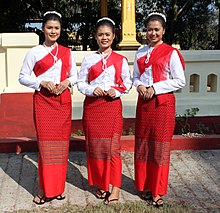Our website is made possible by displaying online advertisements to our visitors.
Please consider supporting us by disabling your ad blocker.
Mon people
 Flag of Mon people | |
 Mon girls wearing traditional dress in Mawlamyine | |
| Total population | |
|---|---|
| c. 1.7 million | |
| Regions with significant populations | |
| c. 1.1 million[a][1] | |
| 200,000[b] | |
| 1,000[b] | |
| Languages | |
| Mon, Burmese, Thai, Lao, Isan, Lanna | |
| Religion | |
| Theravada Buddhism, Mon folk religion, Mon Christian | |
| Related ethnic groups | |
| |
The Mon (Mon: ဂကူမန်; Thai Mon: ဂကူမည်; Burmese: မွန်လူမျိုး, pronounced [mʊ̀ɰ̃ lù mjó]; Thai: มอญ, pronounced [mɔ̄ːn] ) are an ethnic group who inhabit Lower Myanmar's[2] Mon State, Kayin State, Kayah State,[3] Tanintharyi Region, Bago Region, the Irrawaddy Delta, and several areas in Thailand (mostly in Pathum Thani province, Phra Pradaeng and Nong Ya Plong).[4][5][6] The native language is Mon, which belongs to the Monic branch of the Austroasiatic language family and shares a common origin with the Nyah Kur language, which is spoken by the people of the same name that live in Northeastern Thailand. A number of languages in Mainland Southeast Asia are influenced by the Mon language, which is also in turn influenced by those languages.[7][8][9]
The Mon were one of the earliest to reside in Southeast Asia, and were responsible for the spread of Theravada Buddhism in Mainland Southeast Asia.[10][11] The civilizations founded by the Mon were some of the earliest in Thailand as well as Myanmar and Laos. The Mon are regarded as a large exporter of Southeast Asian culture.[12] Historically, many cities in Myanmar, Thailand, and Laos today, including Yangon, Pathum Thani, Lamphun, Lampung and Vientiane were founded either by the Mon people or Mon rulers.
Nowadays, the Mon are a major ethnic group in Myanmar and a minor ethnic group in Thailand.[6] The Mons from Myanmar are called Burmese Mon or Myanmar Mon. The Mons from Thailand are referred as Thai Raman or Thai Mon.[13][14] The Mon dialects of Thailand and Myanmar are mutually intelligible.[15]
Cite error: There are <ref group=lower-alpha> tags or {{efn}} templates on this page, but the references will not show without a {{reflist|group=lower-alpha}} template or {{notelist}} template (see the help page).
- ^ "The World Factbook". CIA.gov. Retrieved January 24, 2018.
- ^ Bauer 1990, p. 14.
- ^ World Bank Group (October 1, 2019). Myanmar - Peaceful and Prosperous Communities Project : Social Assessment (PDF) (Report). Retrieved April 4, 2021.
- ^ Foster 1973, p. 204.
- ^ Bauer 1990, p. 19–23.
- ^ a b Gaspar Ruiz-Canela (June 1, 2017). "Mon, Thai minority who once ruled Southeast Asia". Agencia EFE. Retrieved September 5, 2019.
- ^ Matisoff 1991, p. 482.
- ^ McCormick & Jenny 2013, p. 86.
- ^ Jenny 2013.
- ^ Swearer 2002, p. 130–131.
- ^ Khin May Aung (July 24, 2015). "Historical Perspective on Mon Settlements in Myanmar" (PDF). Burma/Myanmar in Transition: Connectivity, Changes and Challenge. International Conference on Burma/Myanmar Studies.
- ^ Desakura (February 24, 2020). "Where does the Mon Pak Lad shortcut?". Stationremodel. Retrieved August 7, 2020.
- ^ Foster 1973, p. 211.
- ^ Ngamying, Keeratiburana & Thidpad 2014.
- ^ Bauer 1990, p. 34.
Previous Page Next Page


